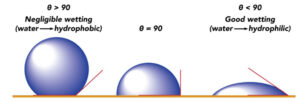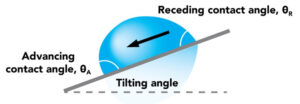by Scott R. Sabreen, president, The Sabreen Group, Inc.
Part one of this series discussed the effects of paint chemistry and plastic compatibility. It would not be acceptable for any element to compromise the plastic properties. The following effects must be evaluated in every application:
- Chemical effects – solvents and chemical interactions cannot damage the plastic part
- Mechanical effects – strength and stiffness properties of the dry coating must be compatible with the plastic and function together as one
- Thermal effects – coating shrinkage cannot relieve molded-in part stresses causing warpage
Adhesion of coatings
Thermoplastics are difficult to wet due to their hydrophobic properties and low surface free energy that can be further lowered by the presence of low molecular weight oxidized materials such as antioxidants, plasticizers, slip and antistatic agents, colorants/pigments and stabilizers. Decorative and protective paint coatings must exhibit good adhesion to be effective. The nature of adhesion has a direct relation with the durability and quality of a coating.
Adhesion of a coating refers to the strong bond between the coating and substrate. Adhesion is one of the essential properties that ensures the coating (dry film) remains adhered to the surface for the life of a product under aggressive conditions. Consider a basic paint system is composed in three parts – the polymer substrate, the interface between the film and the substrate, and the dry paint film. The bond strength between coating and substrate is dependent on the two properties of a material that include:
- Adhesion – the bonding strength of an adhesive or coating to the substrate surface, such as the strength of the bonds forming between one material to another
- Cohesion – the strength of a bond between adhesive particles; in other words, the strength of a bond within the adhesive or film

Cohesion and adhesion are both required for long-term protective coating. Failures associated to adhesion will determine the life of the paint system (Figure 1).
Surface wetting and adhesion is the first factor to consider in designing a coating to optimize adhesion. If a coating in a liquid state does not spread spontaneously over the substrate surface, then there is limited opportunity to form mechanical and chemical bonds with the substrate surface.
Theories of adhesion
There are many theories to explain the mechanism of adhesion – adsorption, chemisorption, mechanical interlocking, electrostatics and diffusion. Some theories are applicable for certain substrates and applications while others differentiate based on various circumstances. Paint systems and adhesion can be characterized by mainly three mechanisms: adsorption, chemical bonding and mechanical interlocking.
Adsorption – Two materials adhere to each other due to attractive forces between the molecules of the materials, known as Van der Waals force. The paint molecules must make intimate molecular contact with the substrate surface. In addition, acid-base interactions and hydrogen bonds also may contribute to intrinsic adhesion forces. This phenomenon is termed “wetting.” Wetting means the liquid flows and covers a surface to maximize the contact area and the attractive forces between the adhesive and adherend bonding surface.

For a liquid to effectively wet out a surface, the surface energy of the coating must be as low or lower than the surface energy of the adherend. Consider a single liquid fluid droplet on a flat solid surface at rest (equilibrium): The angle formed by the solid surface and the tangent line to the upper surface at the endpoint is called the contact angle. It is the angle through the liquid between the tangent line at the contact point and the horizontal line of the solid surface. The droplet shape is due to the molecular forces by which all liquids, through contraction of the surface, tend to form the contained volume into a shape having the least surface area. The intermolecular forces that contract the surface are termed “surface tension.” The higher the surface energy of the solid substrate relative to the surface tension of a liquid the better will be its “wettability” and the smaller the contact angle (Figure 2).

The application of paint fluids is dynamic, not static. When a paint droplet is attached to a solid surface and the solid surface is tilted, the droplet will lunge forward and slide downward. The angles formed are termed, respectively, the advancing angle (θa) and the receding angle (θr) (Figure 3). Contact angles generally are affected by both changes in surface chemistry and changes in surface topography. The advancing contact angle is most sensitive to the low-energy (unmodified) components of the substrate surface, while the receding angle is more sensitive to the high-energy, oxidized groups introduced by surface pretreatments. The receding angle is the measurement most characteristic of the modified component of the surface following pretreatments1.
Chemisorption – An extension of adsorption theory in which adhesion occurs when chemical bonds are formed across the interface. Paint systems are formulated with binders that have a functional group that can chemically bond to a polymer substrate forming strong interfacial bonds. The binder or resin in paint formulation is the non-volatile film-forming component. It ensures adhesion to the substrate and cohesion within the paint film. The type of binder influences film formation, film strength and other properties both physical or chemical.
Mechanical Interlocking – In order to function properly, the paint film must penetrate the cavities on the surface, displace trapped air at the interface and mechanically “lock on” to the substrate. Surface roughness aids in adhesion by increasing the total contact area between the paint and the adherend. Roughening is only effective if the coating completely wets the surface.
Adhesion bond failure: weak-boundary-layer theory
This theory states that bond failure at the interface is caused by either a cohesive break or a weak boundary layer. Weak boundary layers can originate from the adhesive, the adherend, the environment or a combination of any of the three. Weak boundary layers can occur in the adhesive or adherend if an impurity concentrates near the bonding surface and forms a weak attachment to the substrate. When failure takes place, it is the weak boundary layer that fails, although failure appears to take place at the adhesive-adherend interface2. In addition to external contamination, weak boundary layers include low molecular weight constituents (e.g., release agents, plasticizers) on polymeric surfaces. Weak boundary layers must be removed by physical or chemical means so that there is no weak link in the film formation that would contribute to premature coating adhesion failure.
Summary
Adhesion of a coating refers to the strong bond between the coating and substrate. Adhesion is essential to ensure the coating (dry film) remains adhered to the surface for the service life of a product. Cohesion and adhesion are both required for long-term performance. Surface wetting and adhesion is the first factor to consider in designing a coating to optimize adhesion. Paint systems and adhesion can be characterized by mainly three mechanisms adsorption, chemical bonding and mechanical interlocking. According to the weak-boundary-layer theory, when failure takes place, it is the weak boundary layer that fails, although failure appears to take place at the adhesive-adherend interface. Weak boundary layers on polymer surfaces must be removed by physical or chemical means so that there is no weak link in the film formation that would contribute to premature coating adhesion failure.
 Scott R. Sabreen is founder and president of The Sabreen Group, Inc., an engineering consulting company specializing in secondary plastics manufacturing processes – surface pretreatments, adhesion bonding, industrial coatings, inkjet printing, laser marking, decorating and finishing, and product security. Sabreen has been developing pioneering technologies and solving manufacturing problems for more than 30 years. He can be contacted at 972.820.6777 or by visiting www.sabreen.com.
Scott R. Sabreen is founder and president of The Sabreen Group, Inc., an engineering consulting company specializing in secondary plastics manufacturing processes – surface pretreatments, adhesion bonding, industrial coatings, inkjet printing, laser marking, decorating and finishing, and product security. Sabreen has been developing pioneering technologies and solving manufacturing problems for more than 30 years. He can be contacted at 972.820.6777 or by visiting www.sabreen.com.
References
- Sabreen, S. “Inkjet Printing & Adhesion of Low Surface Energy Polymers,” Plastics Decorating 2019
- Causes of Poor Adhesion Weak Boundary Layers, Jacob J. Bikerman, Industrial and Engineering Chemistry, 1967


